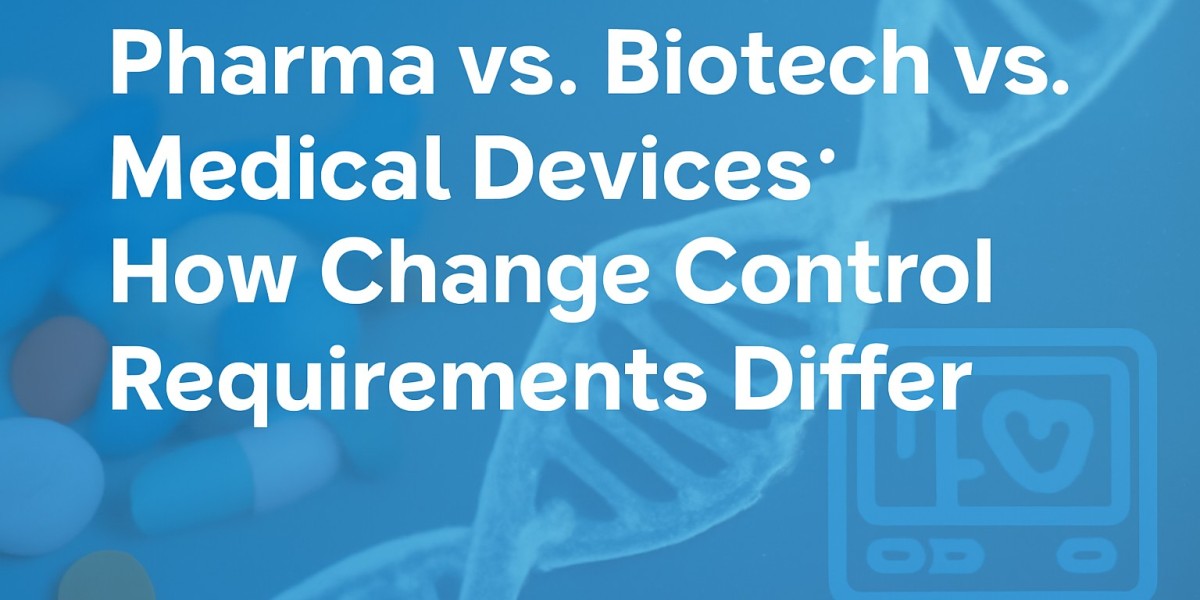In the highly regulated world of life sciences, ensuring the safety, efficacy, and quality of products is paramount. Change control is a critical element of this process, ensuring that any changes to processes, materials, or systems are thoroughly evaluated and compliant with the relevant regulations. However, the specific requirements for managing changes can differ significantly between the pharmaceutical, biotech, and medical device industries. Understanding these differences is essential for companies to navigate their regulatory obligations effectively and remain competitive in an increasingly complex market.
In this blog, we will examine the differences in the change control process in pharmaceutical, biotech, and medical device sectors, and how change control for medical device companies, as well as biotech industry change management software, can help streamline compliance, reduce risks, and improve operational efficiency.
Understanding Change Control Process in Pharmaceutical Industry
The change control process in pharmaceutical industry involves strict regulations and guidelines aimed at ensuring that any change to processes, equipment, or materials does not affect the quality, safety, or efficacy of a product. The process includes assessing the potential impact of the change, obtaining necessary approvals, and thoroughly documenting each modification.
Regulatory Framework for Change Control in Pharma
In the pharmaceutical industry, change control is guided by a set of regulations, such as Good Manufacturing Practices (GMP), that govern every aspect of drug production. The FDA’s 21 CFR Part 211, which deals with drug manufacturing, specifically mandates that changes to production, packaging, and labeling be documented and approved. The goal is to ensure that the end product continues to meet the required safety and quality standards.
Change Control for Medical Device Companies: Unique Considerations
Medical device companies face a set of regulatory requirements that are somewhat similar to pharmaceuticals but with their own distinct needs and considerations. Change control for medical device companies is governed by regulations such as FDA’s 21 CFR Part 820, which applies specifically to medical devices, and ISO 13485, which ensures that devices are manufactured to consistent and safe standards.
Impact of Regulatory Differences on Medical Device Change Control
For medical device companies, any design changes, process modifications, or supplier alterations need to be evaluated for their potential impact on patient safety and product functionality. Unlike pharmaceuticals, which focus primarily on chemical composition, medical device change control also addresses aspects like device performance, mechanical integrity, and electrical safety. A well-managed change control process is critical to ensure that new designs, materials, or manufacturing techniques do not inadvertently compromise the safety and effectiveness of the device.
The Role of Change Control in the Biotech Industry
The biotech industry is distinct from both pharmaceutical and medical device sectors due to its focus on biologics, such as vaccines, gene therapies, and monoclonal antibodies. The change control process in biotech industries is inherently more complex due to the nature of biologics, which can involve living organisms, complex manufacturing processes, and a higher degree of variability.
Complexity of Biotech Change Control
In biotech, changes to raw materials, bioreactors, or the production process can significantly affect product consistency. Biotech companies need to document and assess every change, not just from a regulatory compliance perspective but also to ensure the biological activity of the product is not compromised. Biotech industry change management software is vital for automating this complex process, helping companies track changes efficiently and ensuring they meet the stringent regulatory requirements set by bodies like the FDA and EMA.
Common Challenges in the Change Control Process for Pharma, Biotech, and Medical Devices
Across pharma, biotech, and medical devices, change control presents several common challenges, including maintaining compliance with ever-evolving regulations, tracking and documenting changes across multiple departments, and managing risk. However, the specific nature of these challenges varies from industry to industry, and each sector requires tailored approaches to effectively manage change control.
Globalization and Regulatory Complexity
As companies expand globally, they must adhere to a variety of regulatory standards that can differ from region to region. In the pharmaceutical industry, for instance, the FDA’s 21 CFR regulations may differ from those of the European Medicines Agency (EMA). Similarly, for medical device manufacturers, regulations like the FDA’s 21 CFR Part 820 are different from the European Union Medical Device Regulation (MDR). This regulatory complexity adds an extra layer of difficulty for companies managing change control processes across different markets.
How Change Control Management System for Medical Device Manufacturers Can Streamline Operations
For medical device manufacturers, a change control management system is essential to ensure that changes are managed effectively and in compliance with regulatory standards. A robust system helps streamline the change control process by automating workflows, ensuring consistent documentation, and reducing the risk of human error.
Benefits of a Digital Change Control Management System
By implementing a digital change control management system, medical device manufacturers can ensure a more efficient process for approving, tracking, and documenting changes. These systems integrate with quality management systems (QMS), providing real-time updates and allowing for faster decision-making. Automation tools within the system also help reduce administrative burden, improve collaboration between departments, and ensure compliance with regulatory standards.
The Importance of Biotech Industry Change Management Software
For the biotech industry, managing the change control process is particularly challenging due to the highly regulated nature of biologics and the inherent variability of biological products. Biotech companies need to document every change, perform risk assessments, and ensure that changes do not affect product safety or efficacy.
Leveraging Biotech Change Management Software for Compliance and Efficiency
Biotech industry change management software provides biotech companies with the tools needed to streamline the change control process. These tools facilitate collaboration between departments such as R&D, quality assurance, and production, ensuring that all stakeholders are aligned. Additionally, the software helps track changes across multiple systems, providing a centralized platform that ensures all modifications are documented, reviewed, and approved in line with regulatory guidelines.
Risk Management in Change Control: A Common Thread Across Industries
Risk management is an integral part of the change control process across pharma, biotech, and medical devices. Regardless of the industry, assessing the potential risks of changes is vital to ensure that the end product meets safety, efficacy, and regulatory standards.
The Role of Risk Assessment in Change Control
The risk assessment process in change control involves evaluating how a proposed change could impact product quality, regulatory compliance, or patient safety. In pharma, this may involve evaluating the impact of a new raw material on drug efficacy. In medical devices, it could involve assessing how a design modification affects device performance. Biotech companies must assess how changes in production or raw materials affect biological consistency. This process ensures that only safe, effective changes are implemented, minimizing risks to patients and regulatory non-compliance.
The Need for Seamless Integration Across Departments
Whether in pharma, biotech, or medical devices, the change control process often spans multiple departments, including R&D, quality assurance, regulatory affairs, and production. A seamless integration across these functions is critical to ensure that changes are reviewed and approved thoroughly and efficiently.
Benefits of Cross-Departmental Collaboration in Change Control
Cross-departmental collaboration enables stakeholders to evaluate changes from multiple perspectives. For example, a change in raw material might require input from R&D to assess its impact on product formulation, from quality assurance to verify compliance, and from regulatory affairs to ensure the change is compliant with regional regulations. By using integrated change management software, life sciences companies can ensure that all departments are aligned and that changes are efficiently implemented.
Conclusion: Why ComplianceQuest Is Essential for Business in 2025
As life sciences companies navigate an increasingly complex regulatory landscape in 2025, managing the change control process becomes more critical than ever. The differences in change control requirements between pharmaceutical, biotech, and medical device industries require tailored approaches to meet the unique needs of each sector. ComplianceQuest offers a robust, cloud-based platform that provides life sciences companies with the tools they need to streamline change control processes, ensure regulatory compliance, and improve operational efficiency. By automating workflows, providing real-time collaboration, and ensuring complete traceability of changes, ComplianceQuest empowers companies to stay ahead of evolving regulations and maintain the highest standards of product safety and quality. In 2025, ComplianceQuest will be a crucial partner in helping life sciences companies address the challenges of change control and succeed in an increasingly competitive market.





